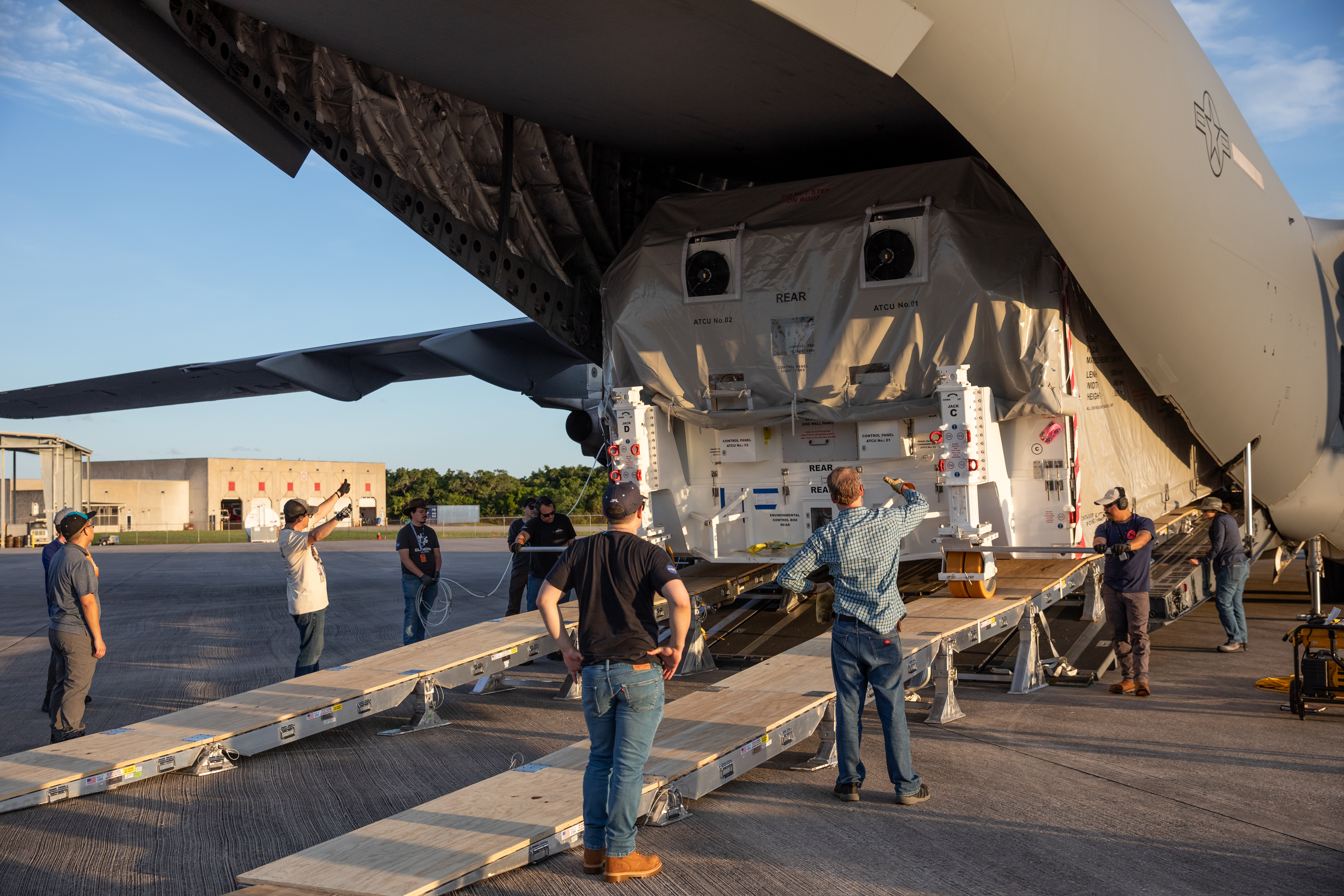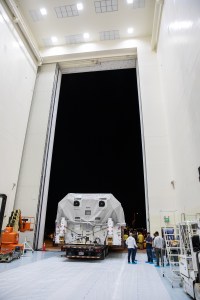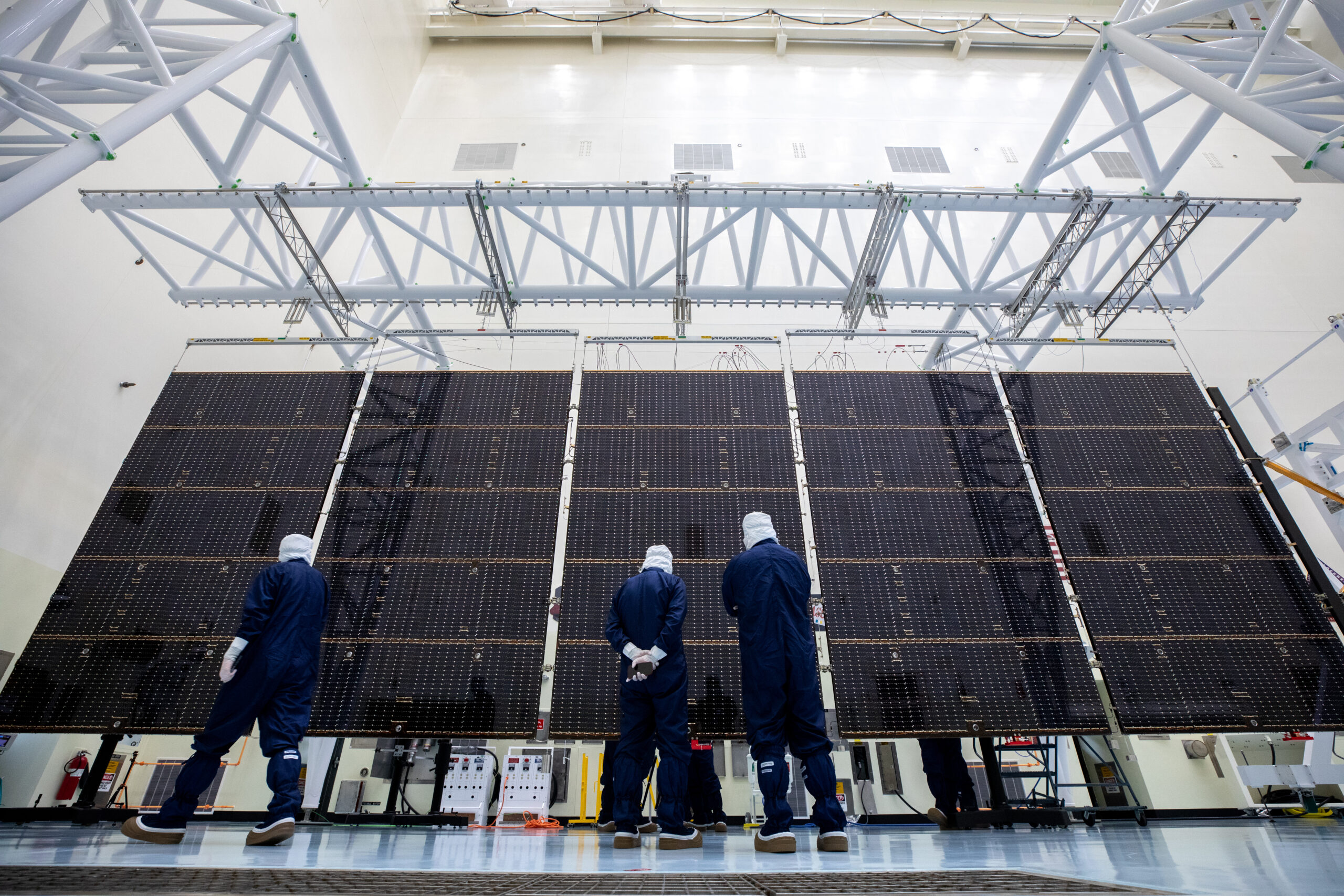NASA’s Kennedy Space Center in Florida remains closed as Hurricane Milton moves off the coast.
The safety of everyone impacted by the storm remains our top priority as the agency begins the assessment and recovery process from the hurricane.
Once the winds subsided to a safe level, the center’s Ride Out Team and engineering teams began initial checkouts to ensure bridges are safe and useable. Later, a larger assessment team will thoroughly check the entire center.
The agency’s Europa Clipper launch team will schedule an official launch date when teams from NASA and SpaceX are able to perform their assessments, and confirm its safe to launch. Teams are working to protect launch opportunities no earlier than Sunday, Oct. 13. Clipper has launch opportunities through Wednesday, Nov. 6.
NASA will provide more information on Clipper launch opportunities as it becomes available.
Tag: Europa Clipper
NASA’s Europa Clipper Makes Cross Country Flight to Florida

NASA’s Europa Clipper, a spacecraft designed to investigate Jupiter’s icy moon Europa and its potential to support life, arrived in Florida on May 23. The spacecraft, assembled at NASA’s Jet Propulsion Laboratory (JPL) in Southern California, landed aboard a United States Air Force C-17 Globemaster III aircraft at the Launch and Landing Facility at NASA’s Kennedy Space Center.
The mission aims to gather detailed measurements of the moon’s surface, interior, and space environment by performing approximately 50 close flybys, some as low as 16 miles from the surface of Europa, which holds a global ocean underneath its ice shell.

“My job for Europa Clipper is to ensure the team meets all the ground and flight requirements to place the spacecraft in the proper orbit to initiate the long journey to Jupiter,” said Armando Piloto, Europa Clipper mission manager for NASA’s Launch Services Program. “The team is excited that the spacecraft is in Florida for processing. We’re pairing Europa Clipper with a fully expendable SpaceX Falcon Heavy rocket to ensure it provides the required performance to explore a destination very far away from Earth.”
Teams at Kennedy spent several hours offloading Europa Clipper before transferring it to the Payload Hazardous Servicing Facility, where they will process the spacecraft and perform final checkouts as part of prelaunch preparations.
Europa Clipper joins the spacecraft’s two five-panel solar arrays that arrived at Kennedy in March. The arrays, each 46.5 feet long (14.2 meters), will collect enough sunlight to power the spacecraft on its way to Jupiter’s moon. Technicians will install the arrays on the spacecraft before launch.
The spacecraft was designed to withstand the pummeling of radiation from Jupiter and gather the measurements needed to investigate Europa’s surface, interior, and space environment.
Europa Clipper has nine dedicated science instruments, including cameras, spectrometers, a magnetometer, and an ice-penetrating radar. These instruments will study Europa’s icy shell, the ocean beneath, and the composition of the gases in the moon’s atmosphere and surface geology, and provide insights into the moon’s potential habitability. The spacecraft also will carry a thermal instrument to pinpoint locations of warmer ice and any possible eruptions of water vapor. Strong evidence shows the ocean beneath Europa’s crust is twice the volume of all the Earth’s oceans combined.
The Europa Clipper mission demonstrates NASA’s commitment to exploring our solar system and searching for habitability beyond Earth. The data will contribute to our understanding of the Jovian system and will help pave the way for potential future missions to study Europa and other potentially habitable worlds.
Europa Clipper is expected to reach the Jupiter system in April 2030, and it will accomplish a few milestones along the way, including a Mars flyby in February 2025 that will help propel the spacecraft toward Jupiter’s moon through a Mars-Earth gravity assist trajectory.

“After two years of painstaking work on the spacecraft here at JPL, with the help of our partners, it was bittersweet to see the spacecraft encased in its shipping container and on its way to Florida,” said Jordan Evans, Europa Clipper project manager at JPL. “But we already have Europa Clipper engineers and technicians at Kennedy who are welcoming this precious cargo and are set to accomplish the final assembly and testing so that we’re ready for launch.”
NASA and SpaceX are targeting launch aboard a Falcon Heavy rocket from Launch Complex 39A at Kennedy later this year. The launch period opens on Oct. 10. After testing and final preparations are complete, the spacecraft will be encapsulated in a protective payload fairing and moved to the SpaceX hangar at the launch complex.
Managed by Caltech in Pasadena, California, JPL leads the development of the Europa Clipper mission in partnership with the Johns Hopkins Applied Physics Laboratory (APL) in Laurel, Maryland, for NASA’s Science Mission Directorate in Washington. The main spacecraft body was designed by APL in collaboration with JPL and NASA’s Goddard Space Flight Center in Greenbelt, Maryland. The Planetary Missions Program Office at NASA’s Marshall Space Flight Center in Huntsville, Alabama, executes program management of the Europa Clipper mission.
NASA’s Launch Services Program, based at Kennedy, manages the launch service for the Europa Clipper spacecraft.
NASA’s Europa Clipper Mission Advances with Solar Array Deployment

Processing of the large solar arrays built for NASA’s Europa Clipper is now underway inside the Payload Hazardous Servicing Facility at the agency’s Kennedy Space Center in Florida.
Planned to arrive at Jupiter in April 2030, the spacecraft will study Jupiter’s moon Europa, which shows strong evidence beneath its icy crust of a global ocean over twice the volume of all Earth’s oceans. Europa is currently considered one of the most promising habitable environments in our solar system.

Once processing of the first five-panel solar array is complete, technicians will remove it from the gravity offload fixture, which helps support the weight of the array. The same steps will then be repeated with the second solar array. Built by Airbus in Leiden, Netherlands, the arrays arrived at Kennedy late last month by truck, after travelling to the U.S. by air.
When both solar arrays are installed and deployed on Europa Clipper – the agency’s largest spacecraft ever developed for a planetary mission – the spacecraft will span a total length of more than 100 feet and weigh 7,145 pounds without the inclusion of propellants. The spacecraft needs the large solar arrays to collect enough light to power it as it operates in the Jupiter system, which is more than five times as far from the Sun as Earth.
Europa Clipper is being assembled at NASA’s Jet Propulsion Laboratory in Southern California and is managed in partnership with Johns Hopkins University Applied Physics Laboratory in Laurel, Maryland. The spacecraft will ship to Florida later this year for launch aboard a SpaceX Falcon Heavy rocket from Kennedy’s Launch Complex 39A. NASA’s Launch Services Program, based at Kennedy, is managing the launch service.
Join the conversation and get Europa Clipper mission updates from these accounts:
X: @EuropaClipper, @NASA, @NASAJPL, @NASA_LSP, @NASASolarSystem, @NASAKennedy
Facebook: NASA’s Europa Clipper Mission, NASA, NASA Jet Propulsion Laboratory, NASA’s Launch Services Program, NASA Solar System Exploration, NASA’s Kennedy Space Center
Instagram: @NASA, @NASAJPL, @NASASolarSystem, @NASAKennedy
